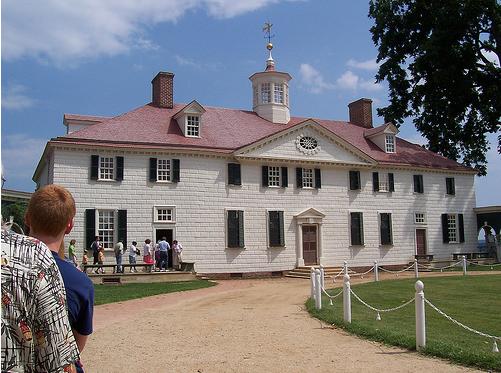
Main Page > 1999 Washington DC: The Capital Crimes Tour >
You there ain't nothin' after a long day of heat and history then a heaping plate of the finest sushi. Mike and Bone gorged themselves on raw fish and Asahi Beer. As the early evening turned into late night the Boys decided on good turn deserves another and went back to the Dubliner for a night cap of Guiney's that ended around 12:30 AM.
After two days of margies, Guiney's, history, and heat. The Boys headed out of the city heading down the Potomac to drop in uninvited to visit George and Martha at Mt. Vernon ! Mount Vernon has an interesting history, after George and Martha's death in 1799, plantation ownership passed through a series of relatives who lacked either the will or the means to maintain the property. After trying unsuccessfully for five years to restore the estate, John Augustine Washington offered it for sale in 1848. The Commonwealth of Virginia and United States governments declined to buy the home and estate. In 1858, the Mount Vernon Ladies' Association of the Union, under the leadership of Ann Pamela Cunningham, acquired the mansion and a portion of the land from Washington's great-grandnephew, John A. Washington, Jr., rescuing it from a state of disrepair and neglect. They paid the final installment of the purchase price of $200,000 (equal to $5,173,333 today) on December 9, 1859, taking possession on February 22, 1860. The estate served as neutral ground for both sides during the American Civil War, although fighting raged across the nearby countryside.
Mike and Bone pulled up to see a very long line of people wanting to visit the very picturesque home of our Nations first President. In fact over 1 million visitors come to walk in Washington's footsteps each year, making Mount Vernon the most popular historic estate in America. Mike and Bone pulled up to see a very long line of people wanting to visit the very picturesque home of our Nations first President.
"Martha ! Lock the doors !!
Here comes Mike and Bone !" George Washington

As Mike and Bone toured the grounds they learned that Mt. George Washington inherited the estate originally known as Little Hunting Creek, due to the untimely death of his brother Lawrence's in July 1752. Lawrence’s Will provided that his widow should own a life estate in Mount Vernon, with the remainder interest falling to Lawrence's beloved half-brother, George. George Washington was already living at Mount Vernon and probably managing the plantation. Lawrence's widow, Anne Fairfax, promptly remarried into the Lee family and moved out. Upon the death of Anne and Lawrence's only surviving child in 1754, George, as executor of his brother's estate, arranged to lease "Mount Vernon" that December. Later, he bought his sister-in-law's life estate and became sole owner of the property.
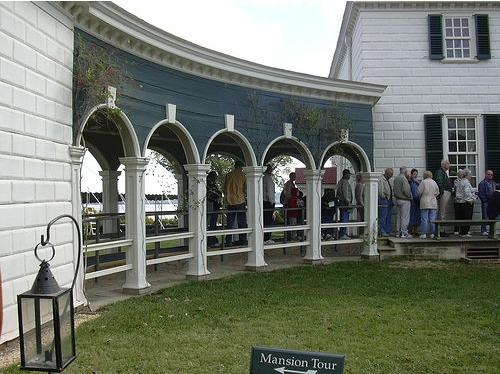
The Picturesque Potomac from Mt. Vernon's Back Porch
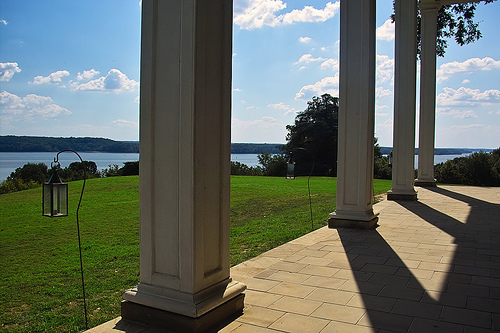
Upon Anne Fairfax Washington Lee's death in 1761, George was the only claimant to the Mount Vernon estate. He had already started purchasing surrounding parcels of land in the late 1750s, and continued adding to the estate well into the 1780s. From 1759 until the Revolutionary War, Washington, who at the time aspired to become a prominent agriculturist, operated the estate as five separate farms, all with this awesome view of the Potomac.
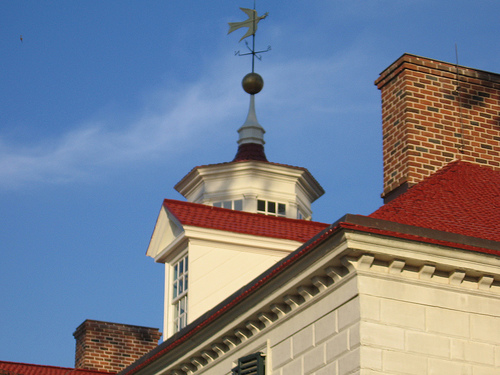
As the Boys went through the House they learned that in 1757, George began the first of two major additions and improvements to the home. The second expansion was begun shortly before the outbreak of the Revolutionary War. On those occasions he entirely rebuilt the main house atop the original foundations, doubling its size each time. The great majority of the work was performed by slaves and artisans. While he twice rebuilt the home, George never changed its patriotic British name, "Mount Vernon".
George's Back Yard
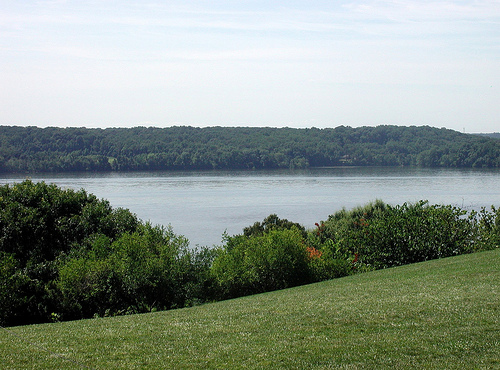
Following his service in the war, Washington returned to Mount Vernon and in 1785-1786 spent a great deal of effort improving the landscaping of the estate. It is estimated that during his two terms as President of the United States (1789–1797) Washington spent only 434 days in residence at Mount Vernon. After his presidency, Washington tended to repairs to the buildings, socializing, and further gardening. Washington selectively bred sheep and grew various types of crops on the plantation, including flax, hemp, cotton and silk: in 1794 he wrote to the gardener at Mount Vernon advising make the most you can of the Indian hemp seed and sow it everywhere. One of his most successful ventures was the establishment of a distillery in 1797; he briefly became one of the new nation's largest distillers of whiskey. Which interested Mike and Bone to no end, with the Boys searching around for any leftover whiskey from George. Alas, there was none left, so the Boys sadly headed down toward the Potomac to visit the final resting places of George and Martha.
George and Martha's First Grave Site
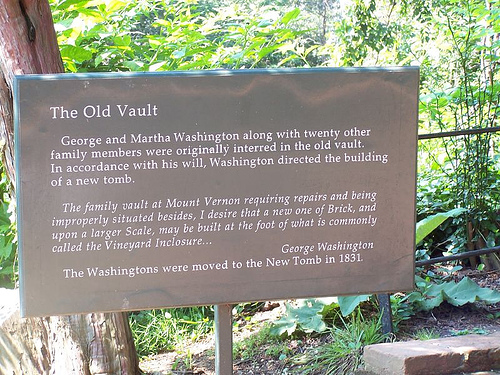
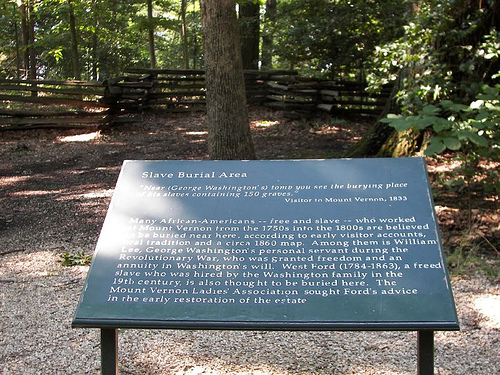
George and Martha's Current Home
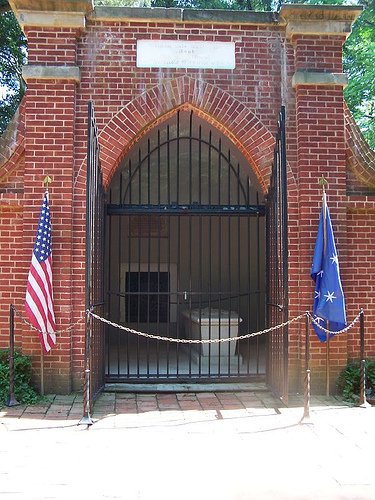
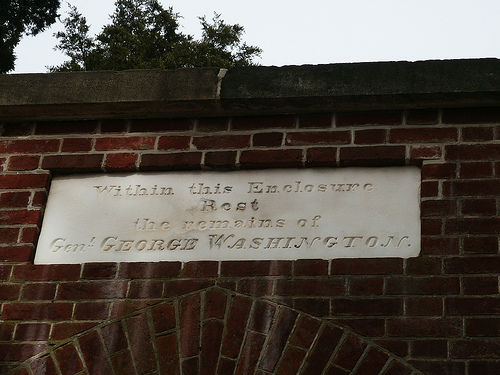
The Mortal Remains of George Washington
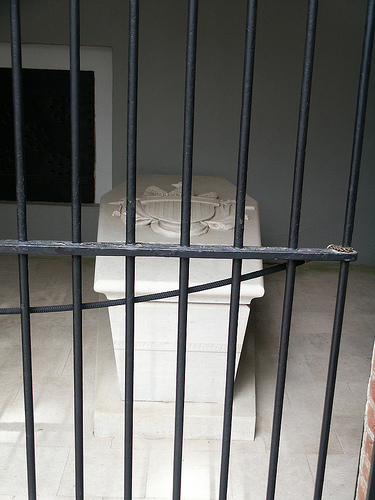
Mike and Bone discovered that the remains of George and Martha Washington, as well as other family members, are entombed on the grounds down by the Potomac. In accordance with his will, Washington was entombed in a family crypt he had built upon first inheriting the estate. It was in disrepair by 1799, so Washington's will also requested that a new, larger tomb be built. This was not done immediately, but following an attempt to rob the grave, in 1831 a new vault was finally constructed in Washington's desired location. It was very cool checking out the place where George was buried, it was very dignified and understated. After paying their respects, the Boys headed to the Boat House for a trip down the Potomac on a Tour Boat!
Checking out the Potomac
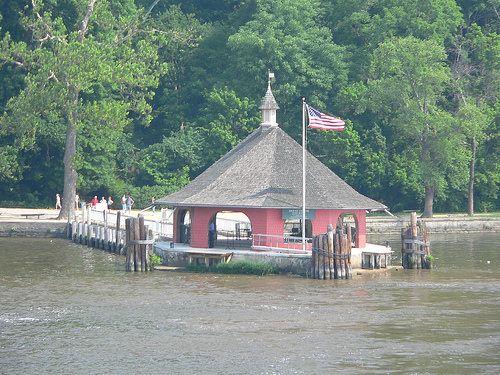
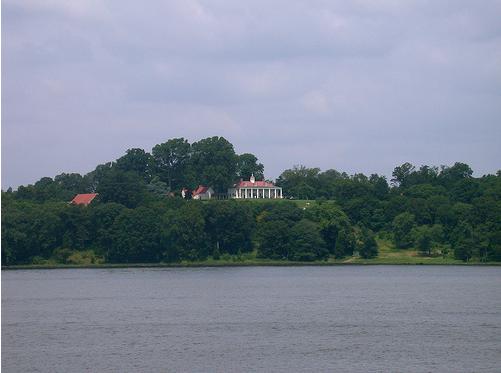
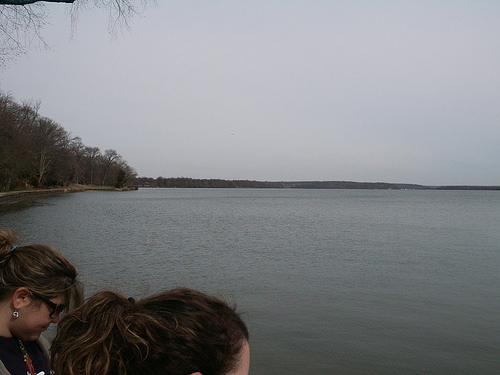
Compare to the small rivers in Michigan the Potomac is huge, Despite the oppressive heat, Mike and Bone enjoyed the 45 minute trip down the Potomac, viewing the estates and farms on the river. What was interesting that despite being one of the oldest English areas in the US, much of the Potomac probably looks the same in a rural sense as it did in George's time. With time running out till the Boys flight home, they had time for one more visit, and that was with another famous (or infamous) Virginia family. The home of Robert E. Lee and Arlington National Cemetery!
The sacred site of Arlington National Cemetery
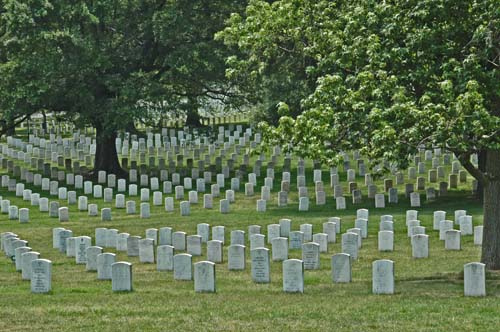
As the Boys learned Arlington National Cemetery in Arlington County, Virginia, is a military cemetery in the United States of America, established during the American Civil War on the grounds of Arlington House, formerly the estate of the family of Confederate general Robert E. Lee's wife Mary Anna (Custis) Lee, a great grand-daughter of Martha Washington. The cemetery is situated directly across the Potomac River from the Lincoln Memorial in Washington, D.C. It is an area of 624 acres with presidents, politicians, notable Americans, veterans and military casualties from each of the nation's wars are interred in the cemetery, ranging from the American Civil War through to the military actions the Gulf War. Pre-Civil War dead were reinterred after 1900.
Why is it on Robert E Lee's estate?. .American military cemeteries developed from the duty of commanders on the frontier and in battle to care for their casualties. When Civil War casualties overflowed hospitals and burial grounds near Washington, D.C., Quartermaster General Montgomery C. Meigs proposed in 1864 that 200 acres of the Robert E. Lee family property at Arlington be confiscated for a cemetery when his own son's body came back from Civil War. It was his way of punishing the Lee's for Robert's turning his back on the Union for the Confederacy as will be explained later.
The Challenger Astronauts
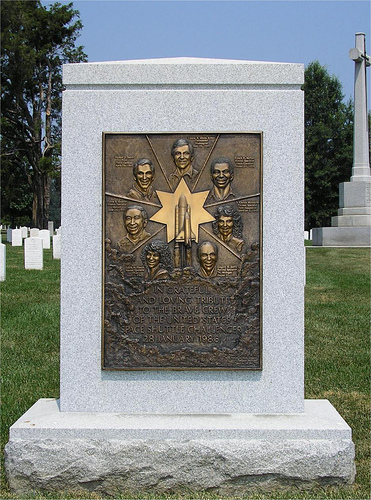
The first soldier to be buried in Arlington was Private William Henry Christman of Pennsylvania on May 13, 1864.There are 367 Medal of Honor recipients buried in Arlington National Cemetery, nine of whom are Canadian. There have been three state funerals have been held at Arlington: those of Presidents William Howard Taft and John F. Kennedy, that of General John J. Pershing. Whether or not they were wartime service members, U.S. presidents are eligible to be buried at Arlington, since they oversaw the armed forces as commanders-in-chief.
The Tomb of the Unknown Soldier
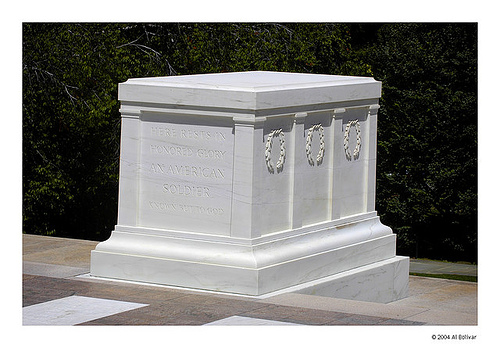
As Mike and Bone check out Arlington, they had to visit the Tomb of the Unknowns, which is a monument dedicated to American service members who have died without their remains being identified. It is also known as the Tomb of the Unknown Soldier though it has never been officially named. While there they had the privilege of observing one of the great ceremonies in the United States,,,, the changing of the Guard.
The Changing of the Guard
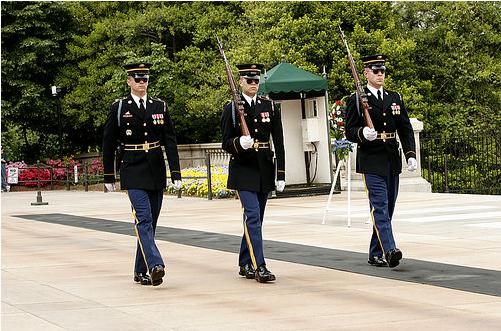
Changing
of the Guard at the Tomb of the Unknowns. There is a quite a ceremony for changing the guard that watches over the graves.
During the day in summer months from April 1 to September 30, the guard is changed every half hour. During the winter months, from October 1 to March 31,
the guard is changed every hour. After the cemetery closes to the public (7 p.m. to 8 a.m. April through September, and 5 p.m. to 8 a.m. October through March),
the guard is changed every 2 hours. The ceremony can be witnessed by the public whenever Arlington National Cemetery is open.
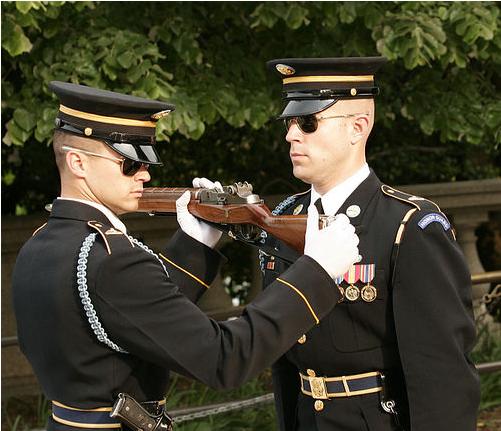
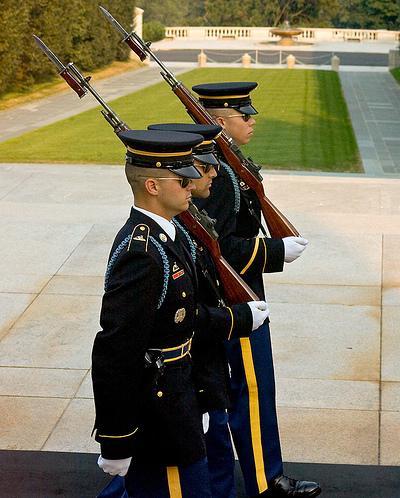
The guard change is very symbolic, but also conducted in accordance with Army hanged every half hour.
The ceremony goes like this:
The relief commander or assistant relief commander, along with the oncoming guard, are both required for a guard change to take place.
The guard being relieved will say to the oncoming guard, "Post and orders remain as directed."
The oncoming guard's response is always, "Orders acknowledged."
Then, the
soldier walks 21 steps across the Tomb. This alludes to the twenty-one gun
salute, which is the highest honor given to any military or foreign
dignitary in
On the 21st step, the soldier turns and faces the Tomb for 21 seconds.
The soldier then turns to face the other way across the Tomb and changes his weapon to the outside shoulder.
After 21 seconds, the first step is repeated.
This is repeated until the soldier is relieved of duty at the Changing of the Guard.
The marines that perform this duty are the best of the best, and it is considered the highest honor to perform post this station. The mat used for the ceremony(shown above) is usually replaced twice per year: before Memorial Day and before Veterans Day. This is required because of the wear on the rubber mat by the special shoes worn by Tomb Guards. The sentinels have metal plates built into the soles and inner parts of their shoes to allow for a more rugged sole and to give the signature click of the heel during maneuvers. The sentinels wear sunglasses because of the bright reflection from the marble surrounding the Tomb and the Memorial Amphitheater. Interestingly on the ground not covered by the mat, a wear pattern in the tile can be seen that corresponds to the precise steps taken during the changing of the guard. On the mat itself, footprints worn in by standing guard are also visible. Mike and Bone were uncharacteristically quiet and respectful during the ceremony, which was simply awesome to observe. Both Boys's had a lump in their throats after the changing of the guard and quietly headed over to JFK's grave site.
JFK's Eternal Flame
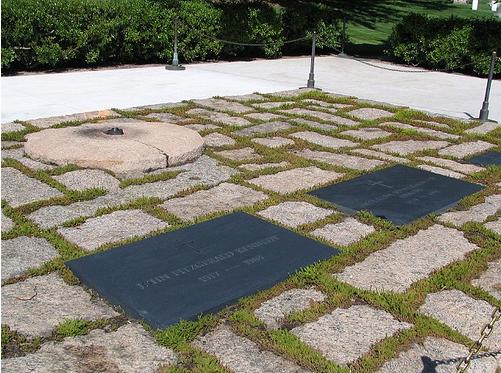
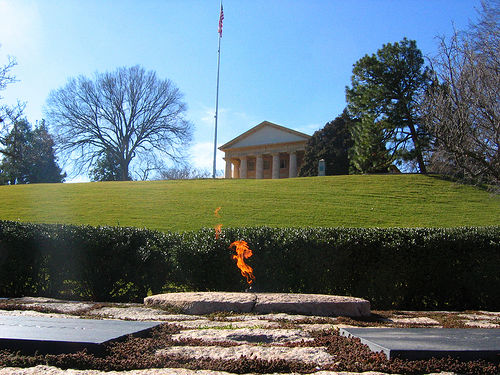
Mike and Bone wondered down to among the most frequently visited sites in the cemetery, which is the grave of President John F. Kennedy, who is buried with his wife, Jacqueline, and two of their children. His remains were interred there on March 14, 1967. The grave is marked with the "eternal flame". The remains of his brother, Senator Robert F. Kennedy is also buried nearby with his grave marked with a simple cross and footstone. Within site of JFK's resting ground is the home of Robert E Lee, and the namesake of the cemetery, Arlington House.
Bobby Lee's Old House
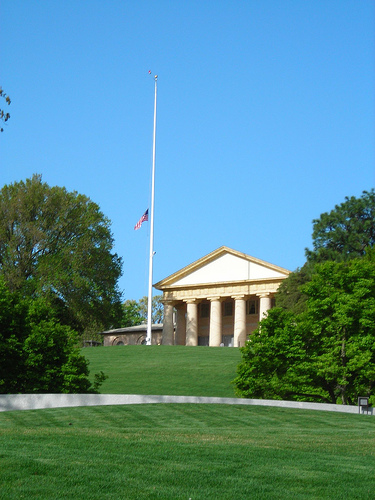
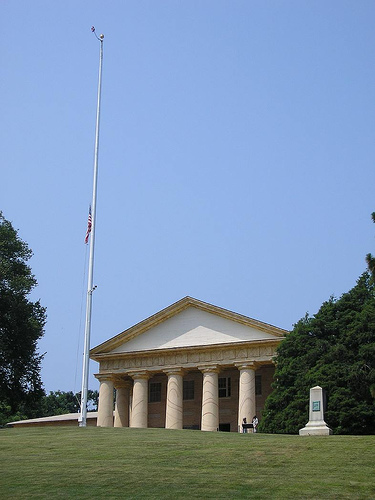
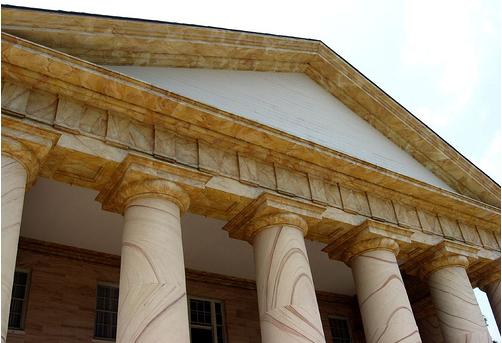
What is the Story of Arlington? On a Virginia hillside rising above the Potomac River and overlooking Washington, D.C., stands Arlington House. The 19th-century mansion seems out of place amid the more than 250,000 military grave sites that stretch out around it. Yet, when construction began in 1802, the estate was not intended to be a national cemetery.
The mansion, which was intended as a living memorial to George Washington, was owned and constructed by the first president's adopted grandson, George Washington Parke Custis, son of John Parke Custis who himself was a child of Martha Washington by her first marriage and a ward of George Washington. Arlington won out as a name over Mount Washington, which is what George Washington Parke Custis first intended calling the 1,100-acre tract of land that he had inherited at the death of his father when he was 3. “Arlington” was the name of the Custis family ancestral estate in the Virginia tidewater area. Custis hired George Hadfield, an English architect who came to Washington in 1785 to help construct the U.S. Capitol, to design his estate. The Greek revival structure which Hadfield designed took Custis sixteen years to complete. The north wing was the first structure completed in 1802. It was in this building that Custis made his home, with a significant portion of it used to store George Washington memorabilia that Custis was acquiring with regularity. Among the items purchased and stored in the north wing were portraits, Washington's personal papers and clothes, and the command tent which the president had used at Yorktown. Even after the completion of the south wing in 1804, Arlington House was still only a set of detached buildings. With the completion of the central section in 1818, the house stretched 140 feet from the north to the south wing. The central section contained a formal dining room and sitting room, a large hall and a parlor. One of the most recognizable of the section's features are the eight columns of the exterior portico, each 5 feet in diameter at the base.
George Washington Parke Custis and his wife, Mary Lee Fitzhugh (whom he had married in 1804), lived in Arlington House for the rest of their lives and were buried together on the property after their deaths in 1857 and 1853, respectively. They are buried in their original graves in Section 13, at map grid N-30.
On June 30, 1831, Custis' only child, Mary Anna Randolph Custis, married her childhood friend and distant cousin, Robert E. Lee. Lee was the son of former three-term Virginia Governor Henry ("Light Horse Harry") Lee and was himself a graduate of West Point. George Washington Parke Custis Between 1841 and 1857, Lee was away from Arlington House for several extended periods. In 1846 he served in the Mexican war under Gen. Winfield Scott, and in 1852 he was appointed superintendent of the U.S. Military Academy at West Point, his alma mater. After his father-in-law died in 1857,
Lee returned to Arlington to join his family and to serve as executor of the estate. Under the terms of her father's will, Mary Anna Custis Lee was given the right to inhabit and control the house for the rest of her life. Custis' will also stipulated that upon Mary Anna's death, full title would pass to her eldest son, George Washington Custis Lee. Contrary to popular belief, Robert E. Lee never owned the Arlington estate. Lee did serve as custodian of the property, which had fallen into disrepair by the time he returned to execute his father-in-law's will. By 1859, Lee had returned the property and its holdings to profitability and good order.
Robert E. Lee and his wife, Mary Anna, lived at Arlington House until 1861, when Virginia ratified an alliance with the Confederacy and seceded from the Union. Lee, who had been named a major general for the Virginia military forces in April 1861, feared for his wife's safety and anticipated the loss of their family inheritance.
In May 1861, Lee wrote to Mary Anna saying: "War is inevitable, and there is not telling when it will burst around you . . . You have to move and make arrangements to go to some point of safety which you must select. The Mount Vernon plate and pictures ought to be secured. Keep quiet while you remain, and in your preparations . . . May God keep and preserve you and have mercy on all our people."
Following the ratification of secession by Virginia, federal troops crossed the Potomac and, under Brig. Gen. Irvin McDowell, took up positions around Arlington. Following the occupation, military installations were erected at several locations around the 1,100-acre estate, including Fort Whipple (now Fort Myer) and Fort McPherson (now Section 11).
Lee deeply regretted the loss of his home at Arlington. During the early stages of the war, foreseeing the probable loss of his home and belongings, Lee wrote to his wife about Arlington: "It is better to make up our minds to a general loss. They cannot take away the remembrance of the spot, and the memories of those that to us rendered it sacred. That will remain to us as long as life will last, and that we can preserve." Lee continued to feel responsible for the estate and earnestly hoped that the slaves who were left behind would be educated and freed, according to the provisions of George Washington Parke Custis' will.
The property was confiscated by the federal government when property taxes levied against Arlington estate were not paid in person by Mrs. Lee. The property was offered for public sale Jan. 11, 1864, and was purchased by a tax commissioner for "government use, for war, military, charitable and educational purposes." Arlington National Cemetery was established by Brig. Gen. Montgomery C. Meigs, who commanded the garrison at Arlington House, appropriated the grounds June 15, 1864, for use as a military cemetery. His intention was to render the house uninhabitable should the Lee family ever attempt to return. A stone and masonry burial vault in the rose garden, 20 feet wide and 10 feet deep, and containing the remains of 1,800 Bull Run casualties, was among the first monuments to Union dead erected under Meigs' orders. Meigs himself was later buried within 100 yards of Arlington House with his wife, father and son; the final statement to his original order.
Neither Robert E. Lee, nor his wife, as title holder, ever attempted to publicly recover control of Arlington House. They were buried at Washington University (later renamed Washington and Lee University) where Lee had served as president. The couple never returned to the home George Washington Parke Custis had built and treasured. After Gen. Lee's death in 1870, George Washington Custis Lee brought an action for ejectment in the Circuit Court of Alexandria (today Arlington) County, Va. Custis Lee, as eldest son of Gen. and Mrs. Lee, claimed that the land had been illegally confiscated and that, according to his grandfather's will, he was the legal owner. In December 1882, the U.S. Supreme Court, in a 5-4 decision, returned the property to Custis Lee, stating that it had been confiscated without due process On March 3, 1883, Congress purchased the property from Lee for $150,000. It became a military reservation and Freedman's Village ceased to exist; however, the gravesites that were once part of the village remained on the grounds of the reservation.
It was quite ironical to Mike and Bone that after visiting Mount Vernon, the Washington-Lee connection at Arlington House. Few American's realized that the wife of the Southern Confederacies most successful General was the great-grand daughter of the Father of the Union, George Washington ! With that the Boys hadda hightail it to the BWI and catch a flight home
Trip, Post Script
It was quite a trip, with a lot of history, heat, and typically Mike and Bone brew stories, that left the Dubliner bereft of beer, the crime rate at an all time high and even George Washington trembling in his grave at the thought of any return of Mike and Bone !